4.4_-_game_theory
40_game_theory_ch_2
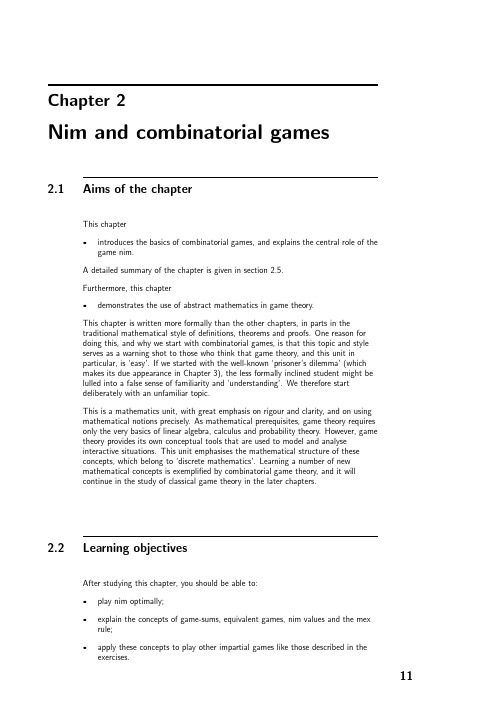
Chapter2Nim and combinatorial games2.1Aims of the chapterThis chapter•introduces the basics of combinatorial games,and explains the central role of the game nim.A detailed summary of the chapter is given in section2.5.Furthermore,this chapter•demonstrates the use of abstract mathematics in game theory.This chapter is written more formally than the other chapters,in parts in thetraditional mathematical style of definitions,theorems and proofs.One reason fordoing this,and why we start with combinatorial games,is that this topic and styleserves as a warning shot to those who think that game theory,and this unit inparticular,is‘easy’.If we started with the well-known‘prisoner’s dilemma’(whichmakes its due appearance in Chapter3),the less formally inclined student might belulled into a false sense of familiarity and‘understanding’.We therefore startdeliberately with an unfamiliar topic.This is a mathematics unit,with great emphasis on rigour and clarity,and on usingmathematical notions precisely.As mathematical prerequisites,game theory requiresonly the very basics of linear algebra,calculus and probability theory.However,gametheory provides its own conceptual tools that are used to model and analyseinteractive situations.This unit emphasises the mathematical structure of theseconcepts,which belong to‘discrete mathematics’.Learning a number of newmathematical concepts is exemplified by combinatorial game theory,and it willcontinue in the study of classical game theory in the later chapters.2.2Learning objectivesAfter studying this chapter,you should be able to:•play nim optimally;•explain the concepts of game-sums,equivalent games,nim values and the mex rule;•apply these concepts to play other impartial games like those described in the exercises.40Game theory2.3Essential readingThis chapter of the guide.2.4Further readingVery few textbooks on game theory deal with combinatorial games.An exception ischapter1of the following book:•Mendelson,Elliot Introducing Game Theory and Its Applications.(Chapman& Hall/CRC,2004)[ISBN1584883006].The winning strategy for the game nim based on the binary system wasfirst describedin the following article,which is available electronically from the JSTOR archive:•Bouton,Charles‘Nim,a game with a complete mathematical theory.’The Annals of Mathematics,2nd Ser.,Vol.3,No.1/4(1902),pp.35–39.The definitive text on combinatorial game theory is the set of volumes‘WinningWays’by Berlekamp,Conway and Guy.The material of this chapter appears in thefirst volume:•Berlekamp,Elwyn R.,John H.Conway and Richard K.Guy Winning Ways for Your Mathematical Plays,Volume1,second edition.(A.K.Peters,2001)[ISBN1568811306].Some small pieces of that text have been copied here nearly verbatim,for example inSections2.7,2.9,and2.12below.The four volumes of‘Winning Ways’are beautiful books.However,they are notsuitable reading for a beginner,because the mathematics is hard,and the reader isconfronted with a wealth of material.The introduction to combinatorial game theorygiven here represents a very small fraction of that body of work,but may invite youto study it further.A very informative and entertaining mathematical tour of parlour games is•Bewersdorff,J¨o rg Logic,Luck and White Lies.(A.K.Peters,2005)[ISBN 1568812108].Combinatorial games are treated in part II of that book.2.5What is combinatorial game theory?This chapter is on the topic of combinatorial games.These are games with twoplayers,perfect information,and no chance moves,specified by certain rules.Familiargames of this sort are chess,go,checkers,tic-tac-toe,dots-and-boxes,and nim.Suchgames can be played perfectly in the sense that either one player can force a win orboth can force a draw.In reality,games like chess and go are too complex tofind anoptimal strategy,and they derive their attraction from the fact that(so far)it is notknown how to play them perfectly.We will,however,learn how to play nim perfectly.There is a‘classical’game theory with applications in economics which is verydifferent from combinatorial game theory.The games in classical game theory aretypically formal models of conflict and co-operation which cannot only be lost orWhat is combinatorial game theory? won,and in which there is often no perfect information about past and future moves.To the economist,combinatorial games are not very interesting.Chapters3–6of theunit are concerned with classical game theory.Why,then,study combinatorial games at all in a unit that is mostly about classicalgame theory,and which aims to provide an insight into the theory of games as usedin economics?The reason is that combinatorial games have a rich and interesting mathematical theory.We will explain the basics of that theory,in particular thecentral role of the game nim for impartial games.It is non-trivial mathematics,it isfun,and you,the student,will have learned something that you would most likelynot have learned otherwise.Thefirst‘trick’from combinatorial game theory is how to win in the game nim,using the binary system.Historically,that winning strategy was discoveredfirst(published by Charles Bouton in1902).Only later did the central importance of nim,in what is known as the Sprague–Grundy theory of impartial games,becomeapparent.It also revealed why the binary system is important(and not,say,theternary system,where numbers are written in base three),and learning that is more satisfying than just learning how to use it.In this chapter,wefirst define the game nim and more general classes of games withperfect information.These are games where every player knows exactly the state ofthe game.We then define and study the concepts listed in the learning outcomesabove,which are the concepts of game-sums,equivalent games,nim values and themex rule.It is best to learn these concepts by following the chapter in detail.Wegive a brief summary here,which will make more sense,and should be re-consulted,after afirst study of the chapter(so do not despair if you do not understand this summary).Mathematically,any game is defined by other‘games’that a player can reach in hisfirst move.These games are called the options of the game.This seemingly circulardefinition of a‘game’is sound because the options are simpler games,which needfewer moves in total until they end.The definition is therefore not circular,butrecursive,and the mathematical tool to argue about such games is that ofmathematical induction,which will be used extensively(it will also recur inchapter3as‘backward induction’for game trees).Here,it is very helpful to befamiliar with mathematical induction for proving statements about natural numbers.We focus here on impartial games,where the available moves are the same nomatter whether player I or player II is the player to make a move.Games are‘combined’by the simple rule that a player can make a move in exactly one of thegames,which defines a sum of these games.In a‘losing game’,thefirst player tomove loses(assuming,as always,that both players play as well as they can).Animpartial game added to itself is always losing,because any move can be copied inthe other game,so that the second player always has a move left.This is known asthe‘copycat’principle(lemma2.6).An important observation is that a losing gamecan be‘added’(via the game-sum operation)to any game without changing thewinning or losing properties of the original game.In section2.11,the central theorem2.10explains the winning strategy in nim.The importance of nim for impartial games is then developed in section2.12via thebeautiful mex rule.After the comparatively hard work of the earlier sections,wealmost instantly obtain that any impartial game is equivalent to a nim heap(corollary2.13).At the end of the chapter,the sizes of these equivalent nim heaps(called nim values)are computed for some examples of impartial games.Many other examples arestudied in the exercises.40Game theoryOur exposition is distinct from the classic text‘Winning Ways’in the followingrespects:First,we only consider impartial games,even though many aspects carryover to more general combinatorial games.Secondly,we use a precise definition ofequivalent games(see section2.10),because a game where you are bound to loseagainst a smart opponent is not the same as a game where you have already lost.Two such games are merely equivalent,and the notion of equivalent games is helpfulin understanding the theory.So this text is much more restricted,but to some extentmore precise than‘Winning Ways’,which should help make this topic accessible andenjoyable.2.6Nim–rulesThe game nim is played with heaps(or piles)of chips(or counters,beans,pebbles,matches).Players alternate in making a move,by removing some chips from one ofthe heaps(at least one chip,possibly the entire heap).Thefirst player who cannotmove any more loses the game.The players will be called,rather unimaginatively,player I and player II,with player Ito start the game.For example,consider three heaps of size1,1,2.What is a good move?Removingone of the chips from the heap with two chips will create the position1,1,1,thenplayer II must move to1,1,then player I to1,and then player II takes the last chipand wins.So this is not a good opening move.The winning move is to remove allchips from the heap of size2,to reach position1,1,and then player I will win.Hence we call1,1,2a winning position,and1,1a losing position.When moving in a winning position,the player to move can win by playing well,bymoving to a losing position of the other player.In a losing position,the player tomove will lose no matter what move she chooses,if her opponent plays well.Thismeans that all moves from a losing position lead to a winning position of theopponent.In contrast,one needs only one good move from a winning position thatgoes to a losing position of the next player.Another winning position consists of three nim heaps of sizes1,1,1.Here all movesresult in the same position and player I always wins.In general,a player in a winningposition must play well by picking the right move.We assume that players play well,forcing a win if they can.Suppose nim is played with only two heaps.If the two heaps have equal size,forexample in position4,4,then thefirst player to move loses(so this is a losingposition),because player II can always copy player I’s move by equalising the twoheaps.If the two heaps have different sizes,then player I can equalise them byremoving an appropriate number of chips from the larger heap,putting player II in alosing position.The rule for2-heap nim is therefore:Lemma2.1The nim position m,n is winning if and only if m=n,otherwise losing,for all m,n≥0.This lemma applies also when m=0or n=0,and thus includes the cases that oneor both heap sizes are zero(meaning only one heap or no heap at all).With three or more heaps,nim becomes more difficult.For example,it is notimmediately clear if,say,positions1,4,5or2,3,6are winning or losing positions.⇒At this point,you should try exercise2.1(a)on page28.Combinatorial games,in particular impartial games 2.7Combinatorial games,in particular impartial gamesThe games we study in this chapter have,like nim,the following properties:1.There are just two players.2.There are several,usuallyfinitely many,positions,and sometimes a particularstarting position.3.There are clearly defined rules that specify the moves that either player canmake from a given position to the possible new positions,which are called theoptions of that position.4.The two players move alternately,in the game as a whole.5.In the normal play convention a player unable to move loses.6.The rules are such that play will always come to an end because some player willbe unable to move.This is called the ending condition.So there can be nogames which are drawn by repetition of moves.7.Both players know what is going on,so there is perfect information.8.There are no chance moves such as rolling dice or shuffling cards.9.The game is impartial,that is,the possible moves of a player only depend onthe position but not on the player.As a negation of condition5,there is also the mis`e re play convention where a playerunable to move wins.In the surrealist(and unsettling)movie‘Last year atMarienbad’by Alain Resnais from1962,mis`e re nim is played,several times,withrows of matches of sizes1,3,5,7.If you have a chance,try to watch that movie andspot when the other player(not the guy who brought the matches)makes a mistake!Note that this is mis`e re nim,not nim,but you will be able tofind out how to play itonce you know how to play nim.(For games other than nim,normal play and mis`e reversions are typically not so similar.)In contrast to condition9,games where the available moves depend on the player(as in chess where one player can only move white pieces and the other only blackpieces)are called partisan games.Much of combinatorial game theory is aboutpartisan games,which we do not consider to keep matters simple.Chess,and the somewhat simpler tic-tac-toe,also fail condition6because they mayend in a tie or draw.The card game poker does not have perfect information(asrequired in7)and would lose all its interest if it had.The analysis of poker,althoughit is also a win-or-lose game,leads to the‘classical’theory of zero-sum games(withimperfect information)that we will consider later.The board game backgammon is agame with perfect information but with chance moves(violating condition8)because dice are rolled.We will be relatively informal in style,but our notions are precise.In condition3above,for example,the term option refers to a position that is reachable in onemove from the current position;do not use‘option’when you mean‘move’.Similarly,we will later use the term strategy to define a plan of moves,one for everyposition that can occur in the game.Do not use‘strategy’when you mean‘move’.However,we will take some liberty in identifying a game with its starting positionwhen the rules of the game are clear.40Game theory⇒Try now exercises2.2and2.3starting on page28.2.8Simpler games and notation for nim heapsA game,like nim,is defined by its rules,and a particular starting position.Let G besuch a particular instance of nim,say with the starting position1,1,2.Knowing therules,we can identify G with its starting position.Then the options of G are1,2,and1,1,1,and1,1.Here,position1,2is obtained by removing either thefirst or thesecond heap with one chip only,which gives the same result.Positions1,1,1and1,1are obtained by making a move in the heap of size two.It is useful to list the optionssystematically,considering one heap to move in at a time,so as not to overlook anyoption.Each of the options of G is the starting position of another instance of nim,definingone of the new games H,J,K,say.We can also say that G is defined by the movesto these games H,J,K,and we call these games also the options of G(byidentifying them with their starting positions;recall that the term‘option’has beendefined in point3of section2.7).That is,we can define a game as follows:Either the game has no move,and theplayer to move loses,or a game is given by one or several possible moves to newgames,in which the other player makes the initial move.In our example,G isdefined by the possible moves to H,J,or K.With this definition,the entire game iscompletely specified by listing the initial moves and what games they lead to,because all subsequent use of the rules is encoded in those games.This is a recursive definition because a‘game’is defined in terms of‘game’itself.We have to add the ending condition that states that every sequence of moves in agame must eventually end,to make sure that a game cannot go on indefinitely.This recursive condition is similar to defining the set of natural numbers as follows:(a)0is a natural number;(b)if n is a natural number,then so is n+1;and(c)allnatural numbers are obtained in this way,starting from0.Condition(c)can beformalised by the principle of induction that says:if a property P(n)is true for n=0,and if the property P(n)implies P(n+1),then it is true for all natural numbers.We use the following notation for nim heaps.If G is a single nim heap with nchips,n≥0,then we denote this game by∗n.This game is completely specified byits options,and they are:options of∗n:∗0,∗1,∗2,...,∗(n−1).(2.1) Note that∗0is the empty heap with no chips,which allows no moves.It is invisiblewhen playing nim,but it is useful to have a notation for it because it defines themost basic losing position.(In combinatorial game theory,the game with no moves,which is the empty nim heap∗0,is often simply denoted as0.)We could use(2.1)as the definition of∗n;for example,the game∗4is defined by itsoptions∗0,∗1,∗2,∗3.It is very important to include∗0in that list of options,because it means that∗4has a winning move.Condition(2.1)is a recursivedefinition of the game∗n,because its options are also defined by reference to suchgames∗k,for numbers k smaller than n.This game fulfils the ending conditionbecause the heap gets successively smaller in any sequence of moves.If G is a game and H is a game reachable by one or more successive moves from thestarting position of G,then the game H is called simpler than G.We will oftenprove a property of games inductively,using the assumption that the property appliesto all simpler games.An example is the–already stated and rather obvious–Sums of games property that one of the two players can force a win.(Note that this applies togames where winning or losing are the only two outcomes for a player,as implied bythe‘normal play’convention in5above.)Lemma2.2In any game G,either the starting player I can force a win,or player IIcan force a win.Proof.When the game has no moves,player I loses and player II wins.Now assumethat G does have options,which are simpler games.By inductive assumption,ineach of these games one of the two players can force a win.If,in all of them,thestarting player(which is player II in G)can force a win,then she will win in G byplaying accordingly.Otherwise,at least one of the starting moves in G leads to agame G where the second-moving player in G (which is player I in G)can force awin,and by making that move,player I will force a win in G.If in G,player I can force a win,its starting position is a winning position,and wecall G a winning game.If player II can force a win,G starts with a losing position,and we call G a losing game.2.9Sums of gamesWe continue our discussion of nim.Suppose the starting position has heap sizes1,5,5.Then the obvious good move is to option5,5,which is losing.What about nim with four heaps of sizes2,2,6,6?This is losing,because2,2and6,6independently are losing positions,and any move in a heap of size2can becopied in the other heap of size2,and similarly for the heaps of size6.There is asecond way of looking at this example,where it is not just two losing games puttogether:consider the game with heap sizes2,6.This is a winning game.However,two such winning games,put together to give the game2,6,2,6,result in a losinggame,because any move in one of the games2,6,for example to2,4,can be copiedin the other game,also to2,4,giving the new position2,4,2,4.So the secondplayer,who plays‘copycat’,always has a move left(the copying move)and hencecannot lose.Definition2.3The sum of two games G and H,written G+H,is defined asfollows:The player may move in either G or H as allowed in that game,leaving theposition in the other game unchanged.Note that G+H is a notation that applies here to games and not to numbers,evenif the games are in some way defined using numbers(for example as nim heaps).The result is a new game.More formally,assume that G and H are defined in terms of their options(via movesfrom the starting position)G1,G2,...,G k and H1,H2,...,H m,respectively.Then theoptions of G+H are given asoptions of G+H:G1+H,...,G k+H,G+H1,...,G+H m.(2.2) Thefirst list of options G1+H,G2+H,...,G k+H in(2.2)simply means that theplayer makes his move in G,the second list G+H1,G+H2,...,G+H m that hemakes his move in H.We can define the game nim as a sum of nim heaps,where any single nim heap isrecursively defined in terms of its options by(2.1).So the game nim with heaps ofsize1,4,6is written as∗1+∗4+∗6.40Game theoryThe‘addition’of games with the abstract+operation leads to an interestingconnection of combinatorial games with abstract algebra.If you are somewhatfamiliar with the concept of an abstract group,you will enjoy this connection;if not,you do not need to worry,because this connection it is not essential for ourdevelopment of the theory.A group is a set with a binary operation+that fulfils three properties:1.The operation+is associative,that is,G+(J+K)=(G+J)+K holds for allG,J,K.2.The operation+has a neutral element0,so that G+0=G and0+G=G forall G.3.Every element G has an inverse−G so that G+(−G)=0.Furthermore,4.The group is called commutative(or‘abelian’)if G+H=H+G holds for allG,H.Familiar groups in mathematics are,for example,the set of integers with addition,orthe set of positive real numbers with multiplication(where the multiplicationoperation is written as·,the neutral element is1,and the inverse of G is written asG−1).The games that we consider form a group as well.In the way the sum of two gamesG and H is defined,G+H and H+G define the same game,so+is commutative.Moreover,when one of these games is itself a sum of games,for example H=J+K,then G+H is G+(J+K)which means the player can make a move in exactly one ofthe games G,J,or K.This means obviously the same as the sum of games(G+J)+K,that is,+is associative.The sum G+(J+K),which is the same as(G+J)+K,can therefore be written unambiguously as G+J+K.An obvious neutral element is the empty nim heap∗0,because it is‘invisible’(itallows no moves),and adding it to any game G does not change the game.However,there is no direct way to get an inverse operation because for any game Gwhich has some options,if one adds any other game H to it(the intention beingthat H is the inverse−G),then G+H will have some options(namely at least theoptions of moving in G and leaving H unchanged),so that G+H is not equal to theempty nim heap.The way out of this is to identify games that are‘equivalent’in a certain sense.Wewill see shortly that if G+H is a losing game(where thefirst player to move cannotforce a win),then that losing game is‘equivalent’to∗0,so that H fulfils the role ofan inverse of G.2.10Equivalent gamesThere is a neutral element that can be added to any game G without changing it.By definition,because it allows no moves,it is the empty nim heap∗0:G+∗0=G.(2.3)However,other games can also serve as neutral elements for the addition of games.We will see that any losing game can serve that purpose,provided we considercertain games as equivalent according to the following definition.Equivalent games Definition2.4Two games G,H are called equivalent,written G≡H,if and only iffor any other game J,the sum G+J is losing if and only if H+J is losing.In definition2.4,we can also say that G≡H if for any other game J,the sum G+Jis winning if and only if H+J is winning.In other words,G is equivalent to H if,whenever G appears in a sum G+J of games,then G can be replaced by H without changing whether G+J is winning or losing.One can verify easily that≡is indeed an equivalence relation,meaning it is reflexive(G≡G),symmetric(G≡H implies H≡G),and transitive(G≡H and H≡K implyG≡K;all these conditions hold for all games G,H,K).Using J=∗0in definition2.4and(2.3),G≡H implies that G is losing if and only ifH is losing.The converse is not quite true:just because two games are winning doesnot mean they are equivalent,as we will see shortly.However,any two losing gamesare equivalent,because they are all equivalent to∗0:Lemma2.5If G is a losing game(the second player to move can force a win),thenG≡∗0.Proof.Let G be a losing game.We want to show G≡∗0By definition2.4,this istrue if and only if for any other game J,the game G+J is losing if and only if∗0+Jis losing.According to(2.3),this holds if and only if J is losing.So let J be any other game;we want to show that G+J is losing if and only if J islosing.Intuitively,adding the losing game G to J does not change which player in Jcan force a win,because any intermediate move in G by his opponent is simplycountered by the winning player,until the moves in G are exhausted.Formally,wefirst prove by induction the simpler claim that for all games J,if J islosing,then G+J is losing.(So wefirst ignore the‘only if’part.)Our inductive assumptions for this simpler claim are:for all losing games G that are simplerthan G,if J is losing,then G +J is losing;and for all games J that are simplerthan J,if J is losing,then G+J is losing.So suppose that J is losing.We want to show that G+J is losing.Any initial movein J leads to an option J which is winning,which means that there is acorresponding option J of J (by player II’s reply)where J is losing.Hence,whenplayer I makes the corresponding initial move from G+J to G+J ,player II cancounter by moving to G+J .By inductive assumption,this is losing because J islosing.Alternatively,player I may move from G+J to G +J.Because G is a losinggame,there is a move by player II from G to G where G is again a losing game,and hence G +J is also losing,by inductive assumption,because J is losing.Thiscompletes the induction and proves the claim.What is missing is to show that if G+J is losing,so is J.If J was winning,then therewould be a winning move to some option J of J where J is losing,but then,by ourclaim(the‘if’part that we just proved),G+J is losing,which would be a winningoption in G+J for player I.But this is a contradiction.This completes the proof.The preceding lemma says that any losing game Z,say,can be added to a game Gwithout changing whether G is winning or losing(in lemma2.5,Z is called G).Thatis,extending(2.3),Z losing=⇒G+Z≡G.(2.4)As an example,consider Z=∗1+∗2+∗3,which is nim with three heaps of sizes1,2,3.To see that Z is losing,we examine the options of Z and show that all ofthem are winning games.Removing an entire heap leaves two unequal heaps,whichis a winning position by lemma2.1.Any other move produces three heaps,two of40Game theorywhich have equal size.Because two equal heaps define a losing nim game Z,they can be ignored by(2.4),meaning that all these options are like single nim heaps and therefore winning positions,too.So Z=∗1+∗2+∗3is losing.The game G=∗4+∗5is clearly winning.By(2.4), the game G+Z is equivalent to G and is also winning.However,verifying directly that∗1+∗2+∗3+∗4+∗5is winning would not be easy to see without using(2.4). It is an easy exercise to show that in sums of games,games can be replaced by equivalent games,resulting in an equivalent sum.That is,for all games G,H,J,G≡H=⇒G+J≡H+J.(2.5)Note that(2.5)is not merely a re-statement of definition2.4,because equivalence of the games G+J and H+J means more than just that the games are either both winning or both losing(see the comments before lemma2.9below).Lemma2.6(The copycat principle)G+G≡∗0for any impartial game G. Proof.Given G,we assume by induction that the claim holds for all simpler games G .Any option of G+G is of the form G +G for an option G of G.This is winning by moving to the game G +G which is losing,by inductive assumption.So G+G is indeed a losing game,and therefore equivalent to∗0by lemma2.5.We now come back to the issue of inverse elements in abstract groups,mentioned at the end of section2.9.If we identify equivalent games,then the addition+of games defines indeed a group operation.The neutral element is∗0,or any equivalent game (that is,a losing game).The inverse of a game G,written as the negative−G,fulfilsG+(−G)≡∗0.(2.6) Lemma2.6shows that for an impartial game,−G is simply G itself.Side remark:For games that are not impartial,that is,partisan games,−G exists also.It is G but with the roles of the two players exchanged,so that whatever move was available to player I is now available to player II and vice versa.As an example, consider the game checkers(with the rule that whoever can no longer make a move loses),and let G be a certain configuration of pieces on the checkerboard.Then−G is the same configuration with the white and black pieces interchanged.Then in the game G+(−G),player II(who can move the black pieces,say),can also play‘copycat’.Namely,if player I makes a move in either G or−G with a white piece, then player II copies that move with a black piece on the other board(−G or G, respectively).Consequently,player II always has a move available and will win the game,so that G+(−G)is indeed a losing game for the starting player I,that is,G+(−G)≡∗0.However,we only consider impartial games,where−G=G.The following condition is very useful to prove that two games are equivalent. Lemma2.7Two impartial games G,H are equivalent if and only if G+H≡∗0.Proof.If G≡H,then by(2.5)and lemma2.6,G+H≡H+H≡∗0.Conversely,G+H≡∗0implies G≡G+H+H≡∗0+H≡H.Sometimes,we want to prove equivalence inductively,where the following observation is useful.Lemma2.8Two games G and H are equivalent if all their options are equivalent, that is,for every option of G there is an equivalent option of H and vice versa.。
game theory lecture4博弈论
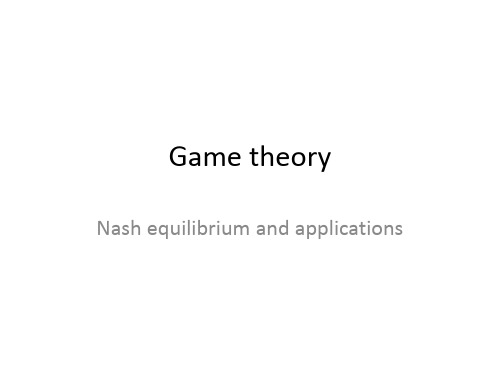
Example 2: Modified Matching Pennies
Player 1
H T
Matching Pennies
• Play the two games in class. • The results are the following:
Matching Pennies Modified Matching Pennies
Mixed Strategy Nash Equilibrium of Example 2 Modified Matching Pennies
• Mixed NE: graph BR1( 2) and BR2( 1) • 1*= BR1( 2*) and 2*= BR1( 1*) yield p = q=¼ • A short-cut to write this Nash equilibrium in mixed strategies is(p = 1/4 ; q = 1/4) • Or, alternatively ( 1*= {1/4, 3/4}, 2*= {1/4, 3/4}.
Example 1 Matching Pennies
• • • • BR2( 1) : Same as player 1 by symmetry u2( 1; 2)=q U2 ( 1;H) + (1-q)U2 ( 1;T) U2 ( 1;H) = p (-1) + (1-p) (1) = 1-2p U2 ( 1;T) = p (1) + (1-p) (-1) = 2p-1 1.if p>1/2,then BR2( 1) =T, i.e. q=0 2.if p<1/2,then BR2( 1) =H , i.e. q=1 3.if p=1/2,then BR2( 1) =H ,T i.e. q=[0,1]
第三节博弈论(GameTheory)

第三节博弈论(Game Theory)在国际关系的研究过程中,我们时常会运用到博弈论这样一个工具。
博弈论在英语中称之为“Game Theory”。
很多人会认为这是一种所谓的游戏理论,其实不然,我们不能把Games 与Fun 同论,而应该将博弈论称之为是一种“Strategic interaction”(策略性互动)。
“博弈”一词现如今在我们的生活中出现的已经很频繁,我们经常会听说各种类型的国家间博弈(如:中美博弈),“博弈论”已经深刻的影响了世界局势和地区局势的发展。
在iChange创设的危机联动体系中,博弈论将得到充分利用,代表也将有机会运用博弈论的知识来解决iChange 核心学术委员会设计的危机。
在这一节中,我将对博弈论进行一个初步的介绍与讨论,代表们可以从这一节中了解到博弈论的相关历史以及一些经典案例的剖析。
(请注意:博弈论的应用范围非常广泛,涵盖数学、经济学、生物学、计算机科学、国际关系、政治学及军事战略等多种学科,对博弈论案例的一些深入分析有时需要运用到高等数学知识,在本节中我们不会涉及较多的数学概念,仅会通过一些基本的数学分析和逻辑推理来方便理解将要讨论的经典博弈案例。
)3.1 从“叙利亚局势”到“零和博弈”在先前关于现实主义理论的讨论中,我们对国家间博弈已经有了初步的了解,那就是国家是有目的的行为体,他们总为了实现自己利益的最大化而选择对自己最有利的战略,其次,政治结果不仅仅只取决于一个国家的战略选择还取决于其他国家的战略选择,多种选择的互相作用,或者策略性互动会产生不同的结果。
因此,国家行为体在选择战略前会预判他国的战略。
在这样的条件下,让我们用一个简单的模型分析一下发生在2013年叙利亚局势1:叙利亚危机从2011年发展至今已经将进入第四个年头。
叙利亚危机从叙利亚政府军屠杀平民和儿童再到使用化学武器而骤然升级,以2013年8月底美国欲对叙利亚动武达到最为紧张的状态,同年9月中旬,叙利亚阿萨德政府以愿意向国际社会交出化学武器并同意立即加入《禁止化学武器公约》的态度而使得局势趋向缓和。
博弈论game theory
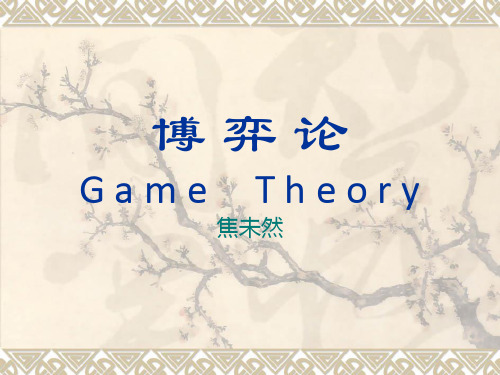
CH2 完全信息静态博弈 §2.1 博弈的解法
2.1.1占优策略 局中人的最优策略不依赖于其他局中人的选择,则称该 局中人有占优策略。如果某策略组合中的每一个策略都是局 中人各自的占优策略,此策略组合称为占优均衡。 囚徒困境中的(坦白,坦白)就是占优均衡,坦白是每 个囚徒的占优策略。但并不是每个博弈,每个局中人都有占 优策略。
博弈论
Game Theory
焦未然
目
完全信息静态博弈 不完全信息静态博弈
录
完全且完美信息动态博弈
重 复 博 弈
基本概念
进化博弈
合作博弈
完全但不完美信息动态博弈
不完全信息动态博弈
1.1.1博弈的基本描述——博弈即游戏 游戏的基本特征:有规则、有结果、有策略、相互依赖性 例子 三人决斗,开枪射杀对手,以保存自己。命中率和 每一轮的开枪次序如下。 命中率 次序 A 30% 1 B 70% 2 C 100% 3 A在第一轮的策略是什么?A最怕什么?首轮之后谁的存 活几率最高?
2.3.3反应函数 对于其他局中人的每一个可能的决策,局中人i都选定 自己的最佳决策。建立这种最佳决策与其他局中人的每一个 可能的决策的映射关系,我们称之为反应函数。局中人反应 函数的交点就是NE。
q2
a b a 2b
a bq 2 q1 2b
E
q2
R1 q2
a bq1 q2 2b a 2b a b
按钮 4,8
0
2.1.3划线法
A B 坦 白
坦
白不 坦 白
猜硬币者 正 盖硬币者 面 反 面
-8,-8 -10,0
0,-10 -1,-1
正
反
面
面
-1,1
Game theory
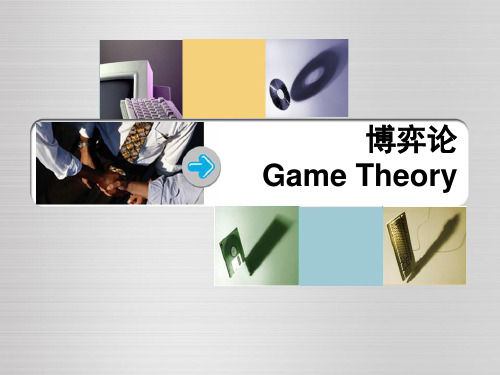
靠左走还是靠右走?
B
靠左行
靠 左 行
靠右行
1, 1
-1, -1
A
靠 右 行
-1, -1
1, 1
南京农业大学经济管理学院 王艳
3、智猪博弈boxed pigs
有一头大猪和一头小猪住在同一个猪圈里,猪圈 的一侧放着猪食槽,另一侧安装着一个控制食物 供应的按钮。按一次按钮,有8个单位的食物进槽 ,但需承担2个单位的成本。 偌大猪小猪同时到达猪食槽,大猪吃到5个单位的 食物,小猪吃到3个单位的食物;若大猪先到,大 猪吃7个单位的食物,小猪只能吃到1个单位;若 小猪先到,小猪吃到4个单位食物,大猪也吃到4 个单位食物。
南京农业大学经济管理学院 王艳
斗鸡博弈
进 A 独木桥
B
退 4,-1 0,0
进
退
-2,-2 -1,4
纳什均衡:A进,B退;A退,B进
南京农业大学经济管理学院 王艳
斗鸡博弈
村子里有两户富户,有两种可能:一家修 ,另一家就不修;一家不修,另一家就得 修。 冷战期间美苏抢占地盘:一方抢占一块地 盘,另一方就占另一块。 夫妻吵架,一方厉害,另一方就出去躲躲 。
南京农业大学经济管理学院 王艳
Reinhard Selten
Sub-game perfect Nash equilibrium 德国波恩大学经济学 系
南京农业大学经济管理学院 王艳
博弈树(扩展型)
参与人 每个参与人选择行动的时点 每个参与人在每次行动时可供选择的行动 集合 每个参与人在每次行动时有关对手过去行 动选择的信息 支付函数
南京农业大学经济管理学院 王艳
博弈树
行动
进入
进入者
在位者
Game_theory_05
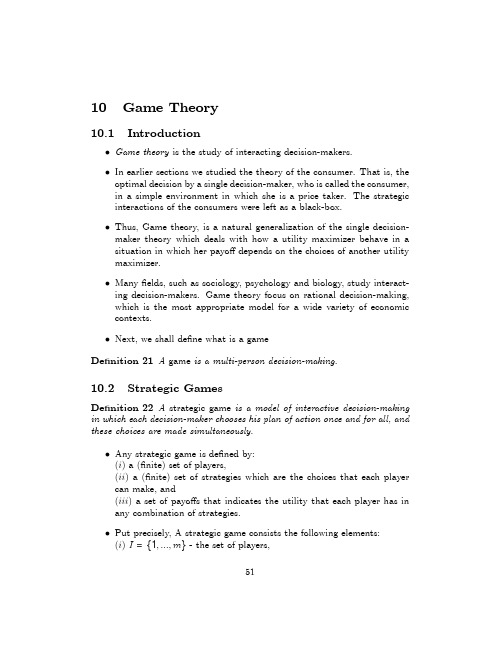
10.3.4
The prisoner dilemma
• Two suspects in a crime are under a police investigation (in different cells). If they both confess (C ), each will be sentenced for three years. If one of them doesn’t confess (D) and the other does, the first one will be used as a witness against the other, who will receive a sentence of four years. If both don’t confess, they will be convicted in minor offense and spend only one year in prison. Table 4 • Class exercise : Find the set of Nash equilibrium N (G). 10.3.5 Hawk-Dove
10.2
Strategic Games
Definition 22 A strategic game is a model of interactive decision-making in which each decision-maker chooses his plan of action once and for all, and these choices are made simultaneously. • Any strategic game is defined by: (i) a (finite) set of players, (ii) a (finite) set of strategies which are the choices that each player can make, and (iii) a set of payoffs that indicates the utility that each player has in any combination of strategies. • Put precisely, A strategic game consists the following elements: (i) I = {1, ..., m} - the set of players, 51
科技英语第二次课_game_theory

Nash equilibrium
纳什均衡,又称为非合作博弈均衡 纳什均衡 又称为非合作博弈均衡 A Nash equilibrium, named after John Nash, is a set of strategies, one for each player, such that no player has incentive to unilaterally change her action.
Game theory was pioneered by Princeton mathematician John von Neumann.
更多具有代表性的例子可能会导致共同得利博弈和共同损 失博弈,同样的情况还会发生在另外一些冲突中。 失博弈,同样的情况还会发生在另外一些冲突中。
Princeton
当我们把博弈的结果表述为一种均衡的时候,并不能假 当我们把博弈的结果表述为一种均衡的时候, 定博弈的每个参与者的个人最佳策略将带来共同的最优 化结果。 化结果。
Nash’s notion of equilibrium remains an incomplete solution to the problem of circular reasoning in simultaneous-move games.
Prisoners’ dilemma
Two suspects are arrested by the police. The police have insufficient evidence for a conviction, and, having separated both prisoners, visit each of them to offer the same deal. If one testifies (defects from the other) for the prosecution against the other and the other remains silent (cooperates with the other), the betrayer goes free and the silent accomplice receives the full 8-year sentence. If both remain silent, both prisoners are sentenced to only one year in jail for a minor charge. If each betrays the other, each receives a five-year sentence. Each prisoner must choose to betray the other or to remain silent. Each one is assured that the other would not know about the betrayal before the end of the investigation. If we assume that each player cares only about minimizing his or her own time in jail, how should the prisoners act?
英语第一章阅读 game theory 原文及翻译
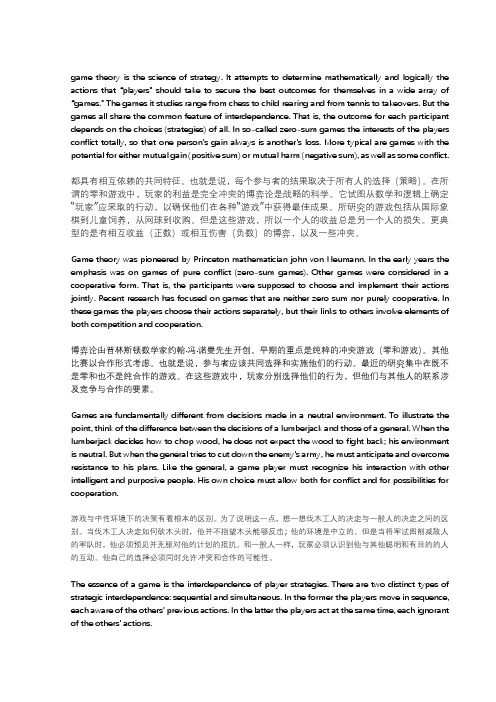
The essence of a game is the interdependence of player strategies. There are two distinct types of strategic interdependence: sequential and simultaneous. In the former the players move in sequence, each aware of the others’ previous actions. In the latter the players act at the same time, each ignorant of the others’ actions.
Game theory was pioneered by Princeton mathematician john von Neumann. In the early years the emphasis was on games of pure conflict (zero-sum games). Other games were considered in a cooperative form. That is, the participants were supposed to choose and implement their actions jointly. Recent research has focused on games that are neither zero sum nor purely cooperative. In these games the players choose their actions separately, but their links to others involve elements of both competition and cooperation.
game theory 教材
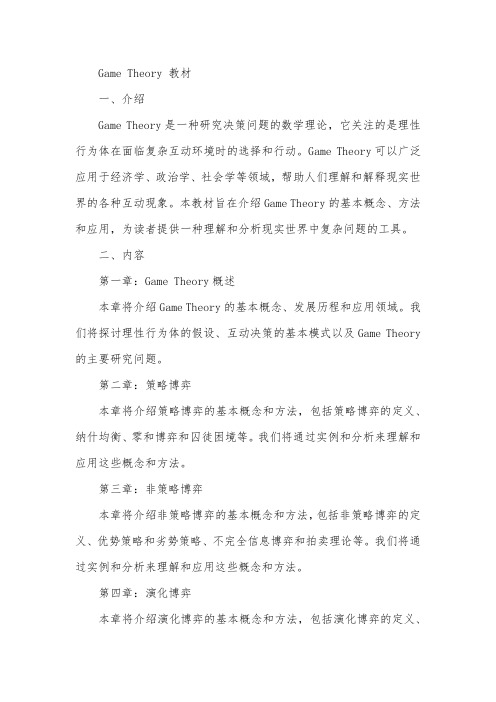
Game Theory 教材一、介绍Game Theory是一种研究决策问题的数学理论,它关注的是理性行为体在面临复杂互动环境时的选择和行动。
Game Theory可以广泛应用于经济学、政治学、社会学等领域,帮助人们理解和解释现实世界的各种互动现象。
本教材旨在介绍Game Theory的基本概念、方法和应用,为读者提供一种理解和分析现实世界中复杂问题的工具。
二、内容第一章:Game Theory概述本章将介绍Game Theory的基本概念、发展历程和应用领域。
我们将探讨理性行为体的假设、互动决策的基本模式以及Game Theory 的主要研究问题。
第二章:策略博弈本章将介绍策略博弈的基本概念和方法,包括策略博弈的定义、纳什均衡、零和博弈和囚徒困境等。
我们将通过实例和分析来理解和应用这些概念和方法。
第三章:非策略博弈本章将介绍非策略博弈的基本概念和方法,包括非策略博弈的定义、优势策略和劣势策略、不完全信息博弈和拍卖理论等。
我们将通过实例和分析来理解和应用这些概念和方法。
第四章:演化博弈本章将介绍演化博弈的基本概念和方法,包括演化博弈的定义、演化稳定性和动态演化博弈等。
我们将通过实例和分析来理解和应用这些概念和方法。
第五章:应用案例本章将介绍Game Theory在经济学、政治学和社会学等领域的应用案例,包括市场交易、政治选举和社会规范等。
我们将通过案例分析和讨论来深入理解和应用Game Theory的概念和方法。
三、结论本教材旨在介绍Game Theory的基本概念、方法和应用,帮助读者理解和分析现实世界中各种复杂的互动现象。
通过阅读和实践,读者可以更好地理解和掌握Game Theory,并应用于解决现实问题中。
复杂网络上演化博弈动力学研究综述
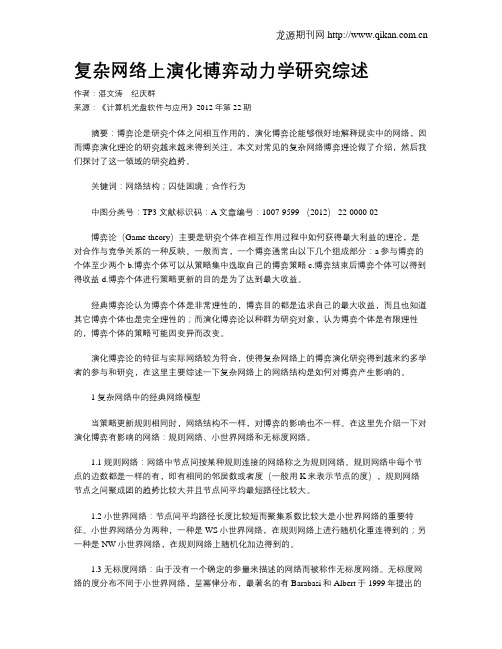
复杂网络上演化博弈动力学研究综述作者:湛文涛纪庆群来源:《计算机光盘软件与应用》2012年第22期摘要:博弈论是研究个体之间相互作用的,演化博弈论能够很好地解释现实中的网络,因而博弈演化理论的研究越来越来得到关注。
本文对常见的复杂网络博弈理论做了介绍,然后我们探讨了这一领域的研究趋势。
关键词:网络结构;囚徒困境;合作行为中图分类号:TP3 文献标识码:A 文章编号:1007-9599 (2012) 22-0000-02博弈论(Game theory)主要是研究个体在相互作用过程中如何获得最大利益的理论,是对合作与竞争关系的一种反映。
一般而言,一个博弈通常由以下几个组成部分:a参与博弈的个体至少两个b.博弈个体可以从策略集中选取自己的博弈策略c.博弈结束后博弈个体可以得到得收益d.博弈个体进行策略更新的目的是为了达到最大收益。
经典博弈论认为博弈个体是非常理性的,博弈目的都是追求自己的最大收益,而且也知道其它博弈个体也是完全理性的;而演化博弈论以种群为研究对象,认为博弈个体是有限理性的,博弈个体的策略可能因变异而改变。
演化博弈论的特征与实际网络较为符合,使得复杂网络上的博弈演化研究得到越来约多学者的参与和研究,在这里主要综述一下复杂网络上的网络结构是如何对博弈产生影响的。
1 复杂网络中的经典网络模型当策略更新规则相同时,网络结构不一样,对博弈的影响也不一样。
在这里先介绍一下对演化博弈有影响的网络:规则网络、小世界网络和无标度网络。
1.1 规则网络:网络中节点间按某种规则连接的网络称之为规则网络。
规则网络中每个节点的边数都是一样的有,即有相同的邻居数或者度(一般用K来表示节点的度),规则网络节点之间聚成团的趋势比较大并且节点间平均最短路径比较大。
1.2 小世界网络:节点间平均路径长度比较短而聚集系数比较大是小世界网络的重要特征。
小世界网络分为两种,一种是WS小世界网络,在规则网络上进行随机化重连得到的;另一种是NW小世界网络,在规则网络上随机化加边得到的。
game theory博弈论

game theory博弈论
游戏理论,也被称为博弈论,是一种研究人类决策和行为的数学框架。
它旨在理解在人类决策中存在的不确定性和竞争条件下,每个参与者的决策如何影响整个系统的结果。
从二战后的经济学开始,游戏理论已经成为经济学、政治学、心理学、哲学和博弈理论的重要研究领域。
它也成为了解决现实生活中许多社会问题的一种有力工具,例如市场竞争、调解博弈、投票、拍卖、国际贸易等。
游戏理论中的核心概念包括博弈、策略、收益和均衡等。
博弈是指参与者之间的相互作用,策略是指参与者制定的行动计划,收益是指参与者对于结果的评价,均衡是指没有参与者有动机改变他们的策略的状态。
在游戏理论中,有许多不同的博弈模型,例如零和博弈、合作博弈、非合作博弈等。
在每种模型中,参与者的决策和行为都会受到不同的影响和限制。
通过了解游戏理论,我们可以更好地理解许多人类行为的原理和动机,同时也可以更好地理解和预测许多社会问题的发展趋势。
- 1 -。
Game Theory (Microeconomic Theory (IV))
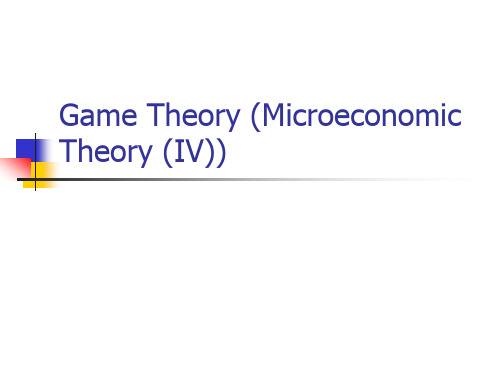
A Formal Definition of NE
In the n-player normal form G {S1,..., Sn ;u1,...,un}
the strategies (s1*,..., sn* )
Cont’d
A maximum number of goats : Gmax : v(G) 0 ,
for G Gmax but v(G) 0 for G Gmax
Also v '(G) 0, v ''(G) 0
The villagers’ problem is simultaneously choosing how many
competing firms? (Convergence to Competitive Equilibrium)
1.4.2 The problem of Commons
David Hume (1739): if people respond only to private incentives, public goods will be underprovided and public resources overutilized.
Cont’d
Firm A’s problem:
A PqA cqA (a qA qB )qA cqA
dA dqA
a 2qA
qB
c
0
qA
a
qB 2
c
d 2 A 2 0
dq
2 A
Cont’d
game theory4 博弈论 英文

If q>0: B is better than T If q=0: B is as good as S
{0} B1(q) =
if q > 0
{p: 0≤p≤1} if q = 0 {1} if p < 1/2 {q: 0≤q≤1} if p = 1/2 {0} if p > 1/2 MSNE: {(p,1-p); (0,1)} p≥1/2
• Game • Elimination of strategies that are strictly dominated by mixed strategies
• illustration • example
2 / 32
Review
MSNE
Elimination By Mixing
Summary
19 / 32
Review
MSNE
Elimination By Mixing
Summary
B1(q) =
{1} if q < 3/4 {p: 0≤p≤1} if q = 3/4 {0} if q > 3/4
B2(p) =
{0} if p < 1/3 {q: 0≤q≤1} if p = 1/3 {1} if p > 1/3
• P2 must be indifferent between L and R: p*1+(1-p)*2 = p*2+(1-p)*1 => p=1/2
9 / 32
Review
MSNE
Elimination By Mixing
Summary
2
1
T (p) B (1-p)
L (q) 0,1 2,2
GAME THEORY
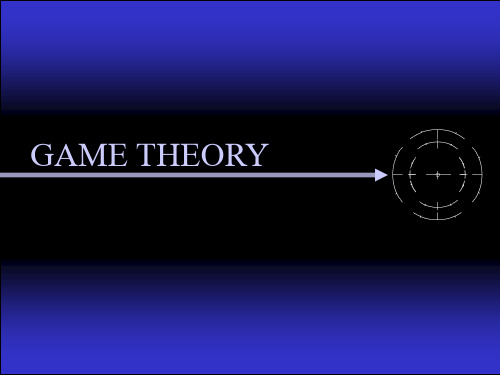
1.2.2 重复剔除的占优均衡
Definition:In a normal-form game, if for each player i , si" is i‟s dominant strategy, than we call the strategies profile (s1″, …, sn" ) the „dominantstrategy equilibrium‟.
1.2.1占优战略均衡
定义2:一个博弈G,若对博弈方i及所用s-i都有 ui (si*,s-i) > ui (si ‟,s-i),则称si*是si ‟的严格上 策, si ‟是si*的严格下策。 定义3:若在博弈G中对每个博弈方i都存在策 略si*是其它所有策略的严格上策,则称策略组 合s*=(s1*,s2*, … ,sn*)是G的上策均衡。
In the normal-form representation of a game ,each
player simultaneously chooses a strategy, and the combination of strategies chosen by the players determines a payoff for each player. Definition: The normal-form representation of an-n-player game specifies the players‟ strategy spaces S1 , … , Sn and their payoff functions u1 ,…, un. We denote this game
Game Theory 2
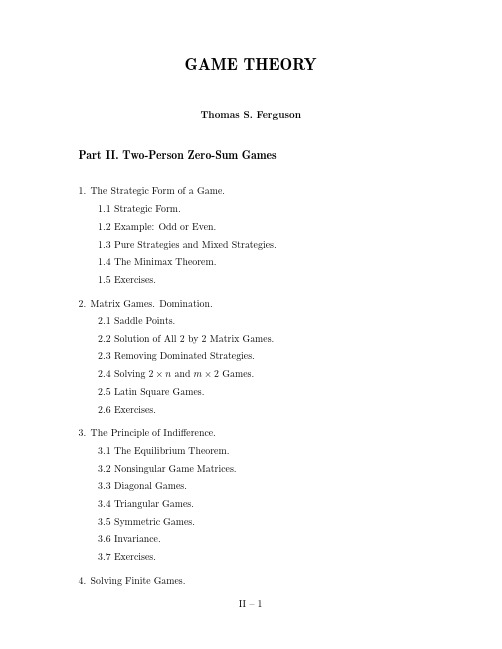
GAME THEORYThomas S.Ferguson Part II.Two-Person Zero-Sum Games1.The Strategic Form of a Game.1.1Strategic Form.1.2Example:Odd or Even.1.3Pure Strategies and Mixed Strategies.1.4The Minimax Theorem.1.5Exercises.2.Matrix Games.Domination.2.1Saddle Points.2.2Solution of All2by2Matrix Games.2.3Removing Dominated Strategies.2.4Solving2×n and m×2Games.2.5Latin Square Games.2.6Exercises.3.The Principle of Indifference.3.1The Equilibrium Theorem.3.2Nonsingular Game Matrices.3.3Diagonal Games.3.4Triangular Games.3.5Symmetric Games.3.6Invariance.3.7Exercises.4.Solving Finite Games.4.1Best Responses.4.2Upper and Lower Values of a Game.4.3Invariance Under Change of Location and Scale.4.4Reduction to a Linear Programming Problem.4.5Description of the Pivot Method for Solving Games.4.6A Numerical Example.4.7Exercises.5.The Extensive Form of a Game.5.1The Game Tree.5.2Basic Endgame in Poker.5.3The Kuhn Tree.5.4The Representation of a Strategic Form Game in Extensive Form.5.5Reduction of a Game in Extensive Form to Strategic Form.5.6Example.5.7Games of Perfect Information.5.8Behavioral Strategies.5.9Exercises.6.Recursive and Stochastic Games.6.1Matrix Games with Games as Components.6.2Multistage Games.6.3Recursive Games. -Optimal Strategies.6.4Stochastic Movement Among Games.6.5Stochastic Games.6.6Approximating the Solution.6.7Exercises.7.Continuous Poker Models.7.1La Relance.7.2The von Neumann Model.7.3Other Models.7.4Exercises.References.Part II.Two-Person Zero-Sum Games1.The Strategic Form of a Game.The individual most closely associated with the creation of the theory of games is John von Neumann,one of the greatest mathematicians of this century.Although others preceded him in formulating a theory of games-notably´Emile Borel-it was von Neumann who published in1928the paper that laid the foundation for the theory of two-person zero-sum games.Von Neumann’s work culminated in a fundamental book on game theory written in collaboration with Oskar Morgenstern entitled Theory of Games and Economic Behavior,1944.Other more current books on the theory of games may be found in the text book,Game Theory by Guillermo Owen,2nd edition,Academic Press,1982,and the expository book,Game Theory and Strategy by Philip D.Straffin,published by the Mathematical Association of America,1993.The theory of von Neumann and Morgenstern is most complete for the class of games called two-person zero-sum games,i.e.games with only two players in which one player wins what the other player loses.In Part II,we restrict attention to such games.We will refer to the players as Player I and Player II.1.1Strategic Form.The simplest mathematical description of a game is the strate-gic form,mentioned in the introduction.For a two-person zero-sum game,the payofffunction of Player II is the negative of the payoffof Player I,so we may restrict attention to the single payofffunction of Player I,which we call here L.Definition1.The strategic form,or normal form,of a two-person zero-sum game is given by a triplet(X,Y,A),where(1)X is a nonempty set,the set of strategies of Player I(2)Y is a nonempty set,the set of strategies of Player II(3)A is a real-valued function defined on X×Y.(Thus,A(x,y)is a real number for every x∈X and every y∈Y.)The interpretation is as follows.Simultaneously,Player I chooses x∈X and Player II chooses y∈Y,each unaware of the choice of the other.Then their choices are made known and I wins the amount A(x,y)from II.Depending on the monetary unit involved, A(x,y)will be cents,dollars,pesos,beads,etc.If A is negative,I pays the absolute value of this amount to II.Thus,A(x,y)represents the winnings of I and the losses of II.This is a very simple definition of a game;yet it is broad enough to encompass the finite combinatorial games and games such as tic-tac-toe and chess.This is done by being sufficiently broadminded about the definition of a strategy.A strategy for a game of chess,for example,is a complete description of how to play the game,of what move to make in every possible situation that could occur.It is rather time-consuming to write down even one strategy,good or bad,for the game of chess.However,several different programs for instructing a machine to play chess well have been written.Each program constitutes one strategy.The program Deep Blue,that beat then world chess champion Gary Kasparov in a match in1997,represents one strategy.The set of all such strategies for Player I is denoted by X.Naturally,in the game of chess it is physically impossible to describe all possible strategies since there are too many;in fact,there are more strategies than there are atoms in the known universe.On the other hand,the number of games of tic-tac-toe is rather small,so that it is possible to study all strategies andfind an optimal strategy for each ter,when we study the extensive form of a game,we will see that many other types of games may be modeled and described in strategic form.To illustrate the notions involved in games,let us consider the simplest non-trivial case when both X and Y consist of two elements.As an example,take the game called Odd-or-Even.1.2Example:Odd or Even.Players I and II simultaneously call out one of the numbers one or two.Player I’s name is Odd;he wins if the sum of the numbers if odd. Player II’s name is Even;she wins if the sum of the numbers is even.The amount paid to the winner by the loser is always the sum of the numbers in dollars.To put this game in strategic form we must specify X,Y and A.Here we may choose X={1,2},Y={1,2}, and A as given in the following table.II(even)yI(odd)x12 1−2+3 2+3−4A(x,y)=I’s winnings=II’s losses.It turns out that one of the players has a distinct advantage in this game.Can you tell which one it is?Let us analyze this game from Player I’s point of view.Suppose he calls‘one’3/5ths of the time and‘two’2/5ths of the time at random.In this case,1.If II calls‘one’,I loses2dollars3/5ths of the time and wins3dollars2/5ths of the time;on the average,he wins−2(3/5)+3(2/5)=0(he breaks even in the long run).2.If II call‘two’,I wins3dollars3/5ths of the time and loses4dollars2/5ths of the time; on the average he wins3(3/5)−4(2/5)=1/5.That is,if I mixes his choices in the given way,the game is even every time II calls ‘one’,but I wins20/c on the average every time II calls‘two’.By employing this simple strategy,I is assured of at least breaking even on the average no matter what II does.Can Player Ifix it so that he wins a positive amount no matter what II calls?Let p denote the proportion of times that Player I calls‘one’.Let us try to choose p so that Player I wins the same amount on the average whether II calls‘one’or‘two’.Then since I’s average winnings when II calls‘one’is−2p+3(1−p),and his average winnings when II calls‘two’is3p−4(1−p)Player I should choose p so that−2p+3(1−p)=3p−4(1−p)3−5p=7p−412p=7p=7/12.Hence,I should call‘one’with probability7/12,and‘two’with probability5/12.On theaverage,I wins−2(7/12)+3(5/12)=1/12,or813cents every time he plays the game,nomatter what II does.Such a strategy that produces the same average winnings no matter what the opponent does is called an equalizing strategy.Therefore,the game is clearly in I’s favor.Can he do better than813cents per gameon the average?The answer is:Not if II plays properly.In fact,II could use the same procedure:call‘one’with probability7/12call‘two’with probability5/12.If I calls‘one’,II’s average loss is−2(7/12)+3(5/12)=1/12.If I calls‘two’,II’s average loss is3(7/12)−4(5/12)=1/12.Hence,I has a procedure that guarantees him at least1/12on the average,and II has a procedure that keeps her average loss to at most1/12.1/12is called the value of the game,and the procedure each uses to insure this return is called an optimal strategy or a minimax strategy.If instead of playing the game,the players agree to call in an arbitrator to settle thisconflict,it seems reasonable that the arbitrator should require II to pay813cents to I.ForI could argue that he should receive at least813cents since his optimal strategy guaranteeshim that much on the average no matter what II does.On the other hand II could arguethat he should not have to pay more than813cents since she has a strategy that keeps heraverage loss to at most that amount no matter what I does.1.3Pure Strategies and Mixed Strategies.It is useful to make a distinction between a pure strategy and a mixed strategy.We refer to elements of X or Y as pure strategies.The more complex entity that chooses among the pure strategies at random in various proportions is called a mixed strategy.Thus,I’s optimal strategy in the game of Odd-or-Even is a mixed strategy;it mixes the pure strategies one and two with probabilities 7/12and5/12respectively.Of course every pure strategy,x∈X,can be considered as the mixed strategy that chooses the pure strategy x with probability1.In our analysis,we made a rather subtle assumption.We assumed that when a player uses a mixed strategy,he is only interested in his average return.He does not care about hismaximum possible winnings or losses—only the average.This is actually a rather drastic assumption.We are evidently assuming that a player is indifferent between receiving5 million dollars outright,and receiving10million dollars with probability1/2and nothing with probability1/2.I think nearly everyone would prefer the$5,000,000outright.This is because the utility of having10megabucks is not twice the utility of having5megabucks.The main justification for this assumption comes from utility theory and is treated in Appendix1.The basic premise of utility theory is that one should evaluate a payoffby its utility to the player rather than on its numerical monetary value.Generally a player’s utility of money will not be linear in the amount.The main theorem of utility theory states that under certain reasonable assumptions,a player’s preferences among outcomes are consistent with the existence of a utility function and the player judges an outcome only on the basis of the average utility of the outcome.However,utilizing utility theory to justify the above assumption raises a new difficulty. Namely,the two players may have different utility functions.The same outcome may be perceived in quite different ways.This means that the game is no longer zero-sum.We need an assumption that says the utility functions of two players are the same(up to change of location and scale).This is a rather strong assumption,but for moderate to small monetary amounts,we believe it is a reasonable one.A mixed strategy may be implemented with the aid of a suitable outside random mechanism,such as tossing a coin,rolling dice,drawing a number out of a hat and so on.The seconds indicator of a watch provides a simple personal method of randomization provided it is not used too frequently.For example,Player I of Odd-or-Even wants an outside random event with probability7/12to implement his optimal strategy.Since 7/12=35/60,he could take a quick glance at his watch;if the seconds indicator showed a number between0and35,he would call‘one’,while if it were between35and60,he would call‘two’.1.4The Minimax Theorem.A two-person zero-sum game(X,Y,A)is said to be afinite game if both strategy sets X and Y arefinite sets.The fundamental theorem of game theory due to von Neumann states that the situation encountered in the game of Odd-or-Even holds for allfinite two-person zero-sum games.Specifically,The Minimax Theorem.For everyfinite two-person zero-sum game,(1)there is a number V,called the value of the game,(2)there is a mixed strategy for Player I such that I’s average gain is at least V no matter what II does,and(3)there is a mixed strategy for Player II such that II’s average loss is at most V no matter what I does.This is one form of the minimax theorem to be stated more precisely and discussed in greater depth later.If V is zero we say the game is fair.If V is positive,we say the game favors Player I,while if V is negative,we say the game favors Player II.1.5Exercises.1.Consider the game of Odd-or-Even with the sole change that the loser pays the winner the product,rather than the sum,of the numbers chosen(who wins still depends on the sum).Find the table for the payofffunction A,and analyze the game tofind the value and optimal strategies of the players.Is the game fair?2.Player I holds a black Ace and a red8.Player II holds a red2and a black7.The players simultaneously choose a card to play.If the chosen cards are of the same color, Player I wins.Player II wins if the cards are of different colors.The amount won is a number of dollars equal to the number on the winner’s card(Ace counts as1.)Set up the payofffunction,find the value of the game and the optimal mixed strategies of the players.3.Sherlock Holmes boards the train from London to Dover in an effort to reach the continent and so escape from Professor Moriarty.Moriarty can take an express train and catch Holmes at Dover.However,there is an intermediate station at Canterbury at which Holmes may detrain to avoid such a disaster.But of course,Moriarty is aware of this too and may himself stop instead at Canterbury.Von Neumann and Morgenstern(loc.cit.) estimate the value to Moriarty of these four possibilities to be given in the following matrix (in some unspecified units).HolmesMoriartyCanterbury Dover Canterbury100−50 Dover0100What are the optimal strategies for Holmes and Moriarty,and what is the value?(His-torically,as related by Dr.Watson in“The Final Problem”in Arthur Conan Doyle’s The Memoires of Sherlock Holmes,Holmes detrained at Canterbury and Moriarty went on to Dover.)4.The entertaining book The Compleat Strategyst by John Williams contains many simple examples and informative discussion of strategic form games.Here is one of his problems.“I know a good game,”says Alex.“We pointfingers at each other;either onefinger or twofingers.If we match with onefinger,you buy me one Daiquiri,If we match with twofingers,you buy me two Daiquiris.If we don’t match I letyou offwith a payment of a dime.It’ll help pass the time.”Olaf appears quite unmoved.“That sounds like a very dull game—at least in its early stages.”His eyes glaze on the ceiling for a moment and his lipsflutterbriefly;he returns to the conversation with:“Now if you’d care to pay me42cents before each game,as a partial compensation for all those55-cent drinks I’llhave to buy you,then I’d be happy to pass the time with you.Olaf could see that the game was inherently unfair to him so he insisted on a side payment as compensation.Does this side payment make the game fair?What are the optimal strategies and the value of the game?2.Matrix Games —DominationA finite two-person zero-sum game in strategic form,(X,Y,A ),is sometimes called a matrix game because the payofffunction A can be represented by a matrix.If X ={x 1,...,x m }and Y ={y 1,...,y n },then by the game matrix or payoffmatrix we mean the matrix A =⎛⎝a 11···a 1n ......a m 1···a mn⎞⎠where a ij =A (x i ,y j ),In this form,Player I chooses a row,Player II chooses a column,and II pays I the entry in the chosen row and column.Note that the entries of the matrix are the winnings of the row chooser and losses of the column chooser.A mixed strategy for Player I may be represented by an m -tuple,p =(p 1,p 2,...,p m )of probabilities that add to 1.If I uses the mixed strategy p =(p 1,p 2,...,p m )and II chooses column j ,then the (average)payoffto I is m i =1p i a ij .Similarly,a mixed strategy for Player II is an n -tuple q =(q 1,q 2,...,q n ).If II uses q and I uses row i the payoffto I is n j =1a ij q j .More generally,if I uses the mixed strategy p and II uses the mixed strategy q ,the (average)payoffto I is p T Aq = m i =1 n j =1p i a ij q j .Note that the pure strategy for Player I of choosing row i may be represented as the mixed strategy e i ,the unit vector with a 1in the i th position and 0’s elsewhere.Similarly,the pure strategy for II of choosing the j th column may be represented by e j .In the following,we shall be attempting to ‘solve’games.This means finding the value,and at least one optimal strategy for each player.Occasionally,we shall be interested in finding all optimal strategies for a player.2.1Saddle points.Occasionally it is easy to solve the game.If some entry a ij of the matrix A has the property that(1)a ij is the minimum of the i th row,and(2)a ij is the maximum of the j th column,then we say a ij is a saddle point.If a ij is a saddle point,then Player I can then win at least a ij by choosing row i ,and Player II can keep her loss to at most a ij by choosing column j .Hence a ij is the value of the game.Example 1.A =⎛⎝41−3325016⎞⎠The central entry,2,is a saddle point,since it is a minimum of its row and maximum of its column.Thus it is optimal for I to choose the second row,and for II to choose the second column.The value of the game is 2,and (0,1,0)is an optimal mixed strategy for both players.For large m ×n matrices it is tedious to check each entry of the matrix to see if it has the saddle point property.It is easier to compute the minimum of each row and the maximum of each column to see if there is a match.Here is an example of the method.row min A =⎛⎜⎝3210012010213122⎞⎟⎠0001col max 3222row min B =⎛⎜⎝3110012010213122⎞⎟⎠0001col max 3122In matrix A ,no row minimum is equal to any column maximum,so there is no saddle point.However,if the 2in position a 12were changed to a 1,then we have matrix B .Here,the minimum of the fourth row is equal to the maximum of the second column;so b 42is a saddle point.2.2Solution of All 2by 2Matrix Games.Consider the general 2×2game matrix A = a b d c.To solve this game (i.e.to find the value and at least one optimal strategy for each player)we proceed as follows.1.Test for a saddle point.2.If there is no saddle point,solve by finding equalizing strategies.We now prove the method of finding equalizing strategies of Section 1.2works when-ever there is no saddle point by deriving the value and the optimal strategies.Assume there is no saddle point.If a ≥b ,then b <c ,as otherwise b is a saddle point.Since b <c ,we must have c >d ,as otherwise c is a saddle point.Continuing thus,we see that d <a and a >b .In other words,if a ≥b ,then a >b <c >d <a .By symmetry,if a ≤b ,then a <b >c <d >a .This shows thatIf there is no saddle point,then either a >b ,b <c ,c >d and d <a ,or a <b ,b >c ,c <d and d >a .In equations (1),(2)and (3)below,we develop formulas for the optimal strategies and value of the general 2×2game.If I chooses the first row with probability p (es the mixed strategy (p,1−p )),we equate his average return when II uses columns 1and 2.ap +d (1−p )=bp +c (1−p ).Solving for p ,we findp =c −d (a −b )+(c −d ).(1)Since there is no saddle point,(a−b)and(c−d)are either both positive or both negative; hence,0<p<1.Player I’s average return using this strategy isv=ap+d(1−p)=ac−bda−b+c−d.If II chooses thefirst column with probability q(es the strategy(q,1−q)),we equate his average losses when I uses rows1and2.aq+b(1−q)=dq+c(1−q)Hence,q=c−ba−b+c−d.(2)Again,since there is no saddle point,0<q<1.Player II’s average loss using this strategyisaq+b(1−q)=ac−bda−b+c−d=v,(3)the same value achievable by I.This shows that the game has a value,and that the players have optimal strategies.(something the minimax theorem says holds for allfinite games). Example2.A=−233−4p=−4−3−2−3−4−3=7/12q=samev=8−9−2−3−4−3=1/12Example3.A=0−1012p=2−10+10+2−1=1/11q=2+100+10+2−1=12/11.But q must be between zero and one.What happened?The trouble is we“forgot to test this matrix for a saddle point,so of course it has one”.(J.D.Williams The Compleat Strategyst Revised Edition,1966,McGraw-Hill,page56.)The lower left corner is a saddle point.So p=0and q=1are optimal strategies,and the value is v=1.2.3Removing Dominated Strategies.Sometimes,large matrix games may be reduced in size(hopefully to the2×2case)by deleting rows and columns that are obviously bad for the player who uses them.Definition.We say the i th row of a matrix A=(a ij)dominates the k th row if a ij≥a kj for all j.We say the i th row of A strictly dominates the k th row if a ij>a kj for all j.Similarly,the j th column of A dominates(strictly dominates)the k th column if a ij≤a ik(resp.a ij<a ik)for all i.Anything Player I can achieve using a dominated row can be achieved at least as well using the row that dominates it.Hence dominated rows may be deleted from the matrix.A similar argument shows that dominated columns may be removed.To be more precise,removal of a dominated row or column does not change the value of a game .However,there may exist an optimal strategy that uses a dominated row or column (see Exercise 9).If so,removal of that row or column will also remove the use of that optimal strategy (although there will still be at least one optimal strategy left).However,in the case of removal of a strictly dominated row or column,the set of optimal strategies does not change.We may iterate this procedure and successively remove several rows and columns.As an example,consider the matrix,A .The last column is dominated by the middle column.Deleting the last column we obtain:A =⎛⎝204123412⎞⎠Now the top row is dominated by the bottomrow.(Note this is not the case in the original matrix).Deleting the top row we obtain:⎛⎝201241⎞⎠This 2×2matrix does not have a saddle point,so p =3/4,q =1/4and v =7/4.I’s optimal strategy in the original game is(0,3/4,1/4);II’s is (1/4,3/4,0).1241 A row (column)may also be removed if it is dominated by a probability combination of other rows (columns).If for some 0<p <1,pa i 1j +(1−p )a i 2j ≥a kj for all j ,then the k th row is dominated by the mixed strategy that chooses row i 1with probability p and row i 2with probability 1−p .Player I can do at least as well using this mixed strategy instead of choosing row k .(In addition,any mixed strategy choosing row k with probability p k may be replaced by the one in which k ’s probability is split between i 1and i 2.That is,i 1’s probability is increased by pp k and i 2’s probability is increased by (1−p )p k .)A similar argument may be used for columns.Consider the matrix A =⎛⎝046574963⎞⎠.The middle column is dominated by the outside columns taken with probability 1/2each.With the central column deleted,the middle row is dominated by the combination of the top row with probability 1/3and the bottom row with probability 2/3.The reducedmatrix, 0693,is easily solved.The value is V =54/12=9/2.Of course,mixtures of more than two rows (columns)may be used to dominate and remove other rows (columns).For example,the mixture of columns one two and threewith probabilities 1/3each in matrix B =⎛⎝135340223735⎞⎠dominates the last column,and so the last column may be removed.Not all games may be reduced by dominance.In fact,even if the matrix has a saddle point,there may not be any dominated rows or columns.The 3×3game with a saddle point found in Example 1demonstrates this.2.4Solving 2×n and m ×2games.Games with matrices of size 2×n or m ×2may be solved with the aid of a graphical interpretation.Take the following example.p 1−p 23154160Suppose Player I chooses the first row with probability p and the second row with proba-bility 1−p .If II chooses Column 1,I’s average payoffis 2p +4(1−p ).Similarly,choices of Columns 2,3and 4result in average payoffs of 3p +(1−p ),p +6(1−p ),and 5p respectively.We graph these four linear functions of p for 0≤p ≤1.For a fixed value of p ,Player I can be sure that his average winnings is at least the minimum of these four functions evaluated at p .This is known as the lower envelope of these functions.Since I wants to maximize his guaranteed average winnings,he wants to find p that achieves the maximum of this lower envelope.According to the drawing,this should occur at the intersection of the lines for Columns 2and 3.This essentially,involves solving the game in which II is restrictedto Columns 2and 3.The value of the game 3116is v =17/7,I’s optimal strategy is (5/7,2/7),and II’s optimal strategy is (5/7,2/7).Subject to the accuracy of the drawing,we conclude therefore that in the original game I’s optimal strategy is (5/7,2/7),II’s is (0,5/7,2/7,0)and the value is 17/7.Fig 2.10123456col.3col.1col.2col.4015/7pThe accuracy of the drawing may be checked:Given any guess at a solution to a game,there is a sure-fire test to see if the guess is correct ,as follows.If I uses the strategy (5/7,2/7),his average payoffif II uses Columns 1,2,3and 4,is 18/7,17/7,17/7,and 25/7respectively.Thus his average payoffis at least17/7no matter what II does.Similarly, if II uses(0,5/7,2/7,0),her average loss is(at most)17/7.Thus,17/7is the value,and these strategies are optimal.We note that the line for Column1plays no role in the lower envelope(that is,the lower envelope would be unchanged if the line for Column1were removed from the graph). This is a test for domination.Column1is,in fact,dominated by Columns2and3taken with probability1/2each.The line for Column4does appear in the lower envelope,and hence Column4cannot be dominated.As an example of a m×2game,consider the matrix associated with Figure2.2.If q is the probability that II chooses Column1,then II’s average loss for I’s three possible choices of rows is given in the accompanying graph.Here,Player II looks at the largest of her average losses for a given q.This is the upper envelope of the function.II wants tofind q that minimizes this upper envelope.From the graph,we see that any value of q between1/4and1/3inclusive achieves this minimum.The value of the game is4,and I has an optimal pure strategy:row2.Fig2.2⎛⎝q1−q154462⎞⎠123456row1row2row3011/41/2qThese techniques work just as well for2×∞and∞×2games.2.5Latin Square Games.A Latin square is an n×n array of n different letters such that each letter occurs once and only once in each row and each column.The5×5 array at the right is an example.If in a Latin square each letter is assigned a numerical value,the resulting matrix is the matrix of a Latin square game.Such games have simple solutions.The value is the average of the numbers in a row,and the strategy that chooses each pure strategy with equal probability1/n is optimal for both players.The reason is not very deep.The conditions for optimality are satisfied.⎛⎜⎜⎜⎝a b c d eb e acd c a de b d c e b ae d b a c ⎞⎟⎟⎟⎠a =1,b =2,c =d =3,e =6⎛⎜⎜⎜⎝1233626133313623362163213⎞⎟⎟⎟⎠In the example above,the value is V =(1+2+3+3+6)/5=3,and the mixed strategy p =q =(1/5,1/5,1/5,1/5,1/5)is optimal for both players.The game of matching pennies is a Latin square game.Its value is zero and (1/2,1/2)is optimal for both players.2.6Exercises.1.Solve the game with matrix−1−3−22 ,that is find the value and an optimal (mixed)strategy for both players.2.Solve the game with matrix 02t 1for an arbitrary real number t .(Don’t forget to check for a saddle point!)Draw the graph of v (t ),the value of the game,as a function of t ,for −∞<t <∞.3.Show that if a game with m ×n matrix has two saddle points,then they have equal values.4.Reduce by dominance to 2×2games and solve.(a)⎛⎜⎝5410432−10−1431−212⎞⎟⎠(b)⎛⎝1007126476335⎞⎠.5.(a)Solve the game with matrix 3240−21−45 .(b)Reduce by dominance to a 3×2matrix game and solve:⎛⎝08584612−43⎞⎠.6.Players I and II choose integers i and j respectively from the set {1,2,...,n }for some n ≥2.Player I wins 1if |i −j |=1.Otherwise there is no payoff.If n =7,for example,the game matrix is⎛⎜⎜⎜⎜⎜⎜⎜⎝0100000101000001010000010100000101000001010000010⎞⎟⎟⎟⎟⎟⎟⎟⎠。
Game theory博弈论
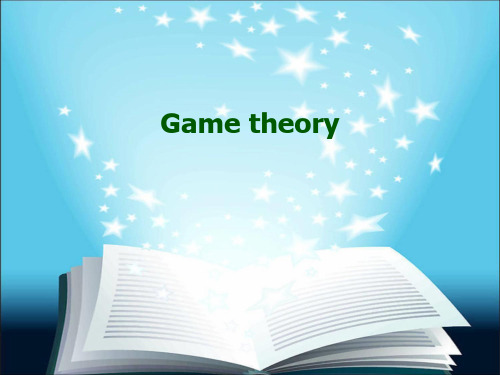
that is:
* * i, xi Si : f i ( xi* , x ) f ( x , x i i i i )
To prove the existence of a Nash Equilibrium, we need using the Kakutani fixed point theorem, John Nash have proved it in 1951.
The end,thank you!
General and applied uses
As a method of applied mathematics, game theory has been used to study a wide variety of human and animal behaviors. It was developed in economics to understand a large collection of economic behaviors. Game theory in the social sciences has been applied to political, sociological, and psychological behaviors as well.
let xi be a strategy profile of player i and
x i be a strategy profile of player i , When each player i {1,, n},
xi resulting in strategy profile x ( x1 xn),
The games studied in game theory are welldefined mathematical objects. To be fully defined, a game must specify the following elements: the players of the game the information the actions available to each player at each decision point the payoffs for each outcome
Game Theory
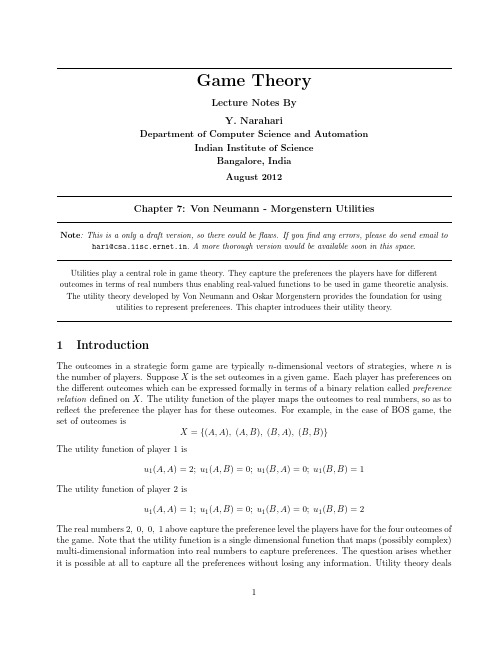
1
Introduction
The outcomes in a strategic form game are typically n-dimensional vectors of strategies, where n is the number of players. Suppose X is the set outcomes in a given game. Each player has preferences on the different outcomes which can be expressed formally in terms of a binary relation called preference relation defined on X . The utility function of the player maps the outcomes to real numbers, so as to reflect the preference the player has for these outcomes. For example, in the case of BOS game, the set of outcomes is X = {(A, A), (A, B ), (B, A), (B, B )} The utility function of player 1 is u1 (A, A) = 2; u1 (A, B ) = 0; u1 (B, A) = 0; u1 (B, B ) = 1 The utility function of player 2 is u1 (A, A) = 1; u1 (A, B ) = 0; u1 (B, A) = 0; u1 (B, B ) = 2 The real numbers 2, 0, 0, 1 above capture the preference level the players have for the four outcomes of the game. Note that the utility function is a single dimensional function that maps (possibly complex) multi-dimensional information into real numbers to capture preferences. The question arises whether it is possible at all to capture all the preferences without losing any information. Utility theory deals 1
- 1、下载文档前请自行甄别文档内容的完整性,平台不提供额外的编辑、内容补充、找答案等附加服务。
- 2、"仅部分预览"的文档,不可在线预览部分如存在完整性等问题,可反馈申请退款(可完整预览的文档不适用该条件!)。
- 3、如文档侵犯您的权益,请联系客服反馈,我们会尽快为您处理(人工客服工作时间:9:00-18:30)。
Game TheoryThemes1. Introduction to Game Theory2. Sequential Games3. Simultaneous Games4. ConclusionIntroduction to Game TheoryGame theory is the branch of decision theory concerned with interdependent decisions. The problems of interest involve multiple participants, each of whom has individual objectives related to a common system or shared resources. Because game theory arose from the analysis of competitive scenarios, the problems are called games and the participants are called players. But these techniques apply to more than just sport, and are not even limited to competitive situations. In short, game theory deals with any problem in which each player’s strategy depends on what the other players do.Situations involving interdependent decisions arise frequently, in all walks of life. A few examples in which game theory could come in handy include:●Friends choosing where to go have dinner●Parents trying to get children to behave●Commuters deciding how to go to work●Businesses competing in a market●Diplomats negotiating a treaty●Gamblers betting in a card gameAll of these situations call for strategic thinking – making use of available information to devise the best plan to achieve one’s objectives. Perhaps you are already familiar with assessing costs and benefits in order to make informed decisions between several options. Game theory simply extends this concept to interdependent decisions, in which the options being evaluated are functions of the players’ choices.The appropriate techniques for analyzing interdependent decisions differ significantly from those for individual decisions. To begin with, despite the rubric game, the object is not to “win.” Even for strictly competitive games, the goal is simply to identify one’s optimal strategy. This may sound like a euphemism, but it is actually an important distinction. Using this methodology, whether or not we end up ahead of another player will be of no consequence; our only concern will be whether we have used our optimal strategy. The reasons for this will become clear as we continue.In gaming, players’ actions are referred to as moves. The role of analysis is to identify the sequence of moves that you should use. A sequence of moves is called a strategy, so an optimal strategy is a sequence of moves that results in your best outcome. (It doesn’t have to be unique; more than one strategy could result in outcomes that had equal payoffs, and they would all be optimal, as long as no other strategy could result in a higher payoff.) There are two fundamental types of games: sequential and simultaneous. In sequential games, the players must alternate moves; in simultaneous games, the players can act at the same time. These types are distinguished because they require different analytical approaches. The sections below present techniques for analyzing sequential and simultaneous games, and we conclude with a few words about some advanced game theory concepts.Sequential GamesTo analyze a sequential game, first construct a game tree mapping out all of the possibilities.* Then follow the basic strategic rule: “look ahead and reason back:” †1. Look ahead to the very last decision, and assume that if it comes to that point, thedeciding player will choose his/her optimal outcome (the highest payoff, or otherwise most desirable result).2. Back up to the second-to-last decision, and assume the next player would choosehis/her best outcome, treating the following decision as fixed (because we have already decided what that player will pick if it should come to that).3. Continue reasoning back in this way until all decisions have been fixed.* For those familiar with decision trees, game trees are quite similar. The main difference is that decision trees map decisions for one person only, while game trees map decisions for all players.†All rules and most examples here have been borrowed from: Dixit, Avinash K., and Barry J. Nalebuff. Thinking Strategically. New York: W. W. Norton & Co., 1991. This is an excellent nontechnical book on game theory, and this paper (intended for educational use only) is heavily based upon it.That’s all there is to it. If you actually play out the game after conducting your analysis, you simply make the choices you identified at each of your decisions. The only time you even have to think is if another player makes a “mistake.” Then you must look ahead and reason back again, to see if your optimal strategy has changed.Notice that this procedure assumes that the other players are as smart as we are, and are doing the same analysis. While this may not be the case, it is the only safe assumption. If it is correct, we will have made our best possible decision. For it to be incorrect, an opponent must choose an option not in his/her own best interests.The analytical process is best illustrated through an example. Suppose that a company called Fastcleaners currently dominates the market and makes $300,000 per year, and we are considering starting a competing company. If we enter the market, Fastcleaners will have two choices: accept the competition or fight a price war. Suppose that we have done market analyses from which we expect that if Fastcleaners accepts the competition, each firm will make a profit of $100,000 (the total is less than Fastcleaners alone used to make because they could enjoy monopoly pricing). However, if Fastcleaners fights a price war, they will suffer a net loss of $100,000, and we will lose $200,000. (Note that these are the ultimate payoffs, not just temporary gains or losses that may change over time.)With this information, we can build a game tree (Figure 3.4.1). We begin by mapping the decision structure before including any data: we (“us”) move first, and either enter the market or do not. If we enter, Fastcleaners (“FC”) gets to respond, and either accepts us or starts a price war. If we do not enter, nothing happens. Then we just fill in the numbers listed above, and the tree is complete.Figure 3.4.1: Cleaners Example Game TreeNow we can look ahead and reason back. Looking ahead, if Fastcleaners faces the last choice, it will be between $100,000 profit and $100,000 loss. Naturally, they will choose the profit. Reasoning back, we now know it will not come to a price war, which means our decision is between $100,000 profit and $0 profit. Consequently, we decide to start our company and enter the market, where we expect to make $100,000 profit.Of course this is only a very simple example. A more realistic situation might involve more decision stages (Fastcleaners could begin a price war, and re-evaluate every month) or more factors (Fastcleaners could be a chain, willing to accept a loss at this branch in order to build a reputation of toughness to deter other would-be competitors), but the analytical method of looking ahead and reasoning back will remain valid. It has been proven that there exists an optimal strategy for any sequential game involving a finite number of steps. Note that this doesn’t always mean it is possible to determine. The game of chess technically has an optimal strategy, but no one has yet been able to map out all of the possible combinations of moves. Only specific scenarios have been solved.We end this section with a few observations before moving on to simultaneous games. First, notice that looking ahead and reasoning back determines not just one player’s optimal strategy, but those for all players. It is called the solution to the game. Once it has been determined, it is irrelevant whether or not the game is actually played, as no one can possibly do better than the solution dictates.* That is why the concept of “winning” does not really apply. Alternatively, one could argue that the player who gets to make the last decision wins. Sequential games are determined, so ultimately, there are only two choices: either the player with the last decision gets his/her best outcome, or the game is not played. Thus, the game tree obviates the need to actually play out the game. Simultaneous GamesTurning to simultaneous games, it is immediately apparent that they must be handled differently, because there is not necessarily any last move. Consider a simple, but very famous example, called the Prisoner’s Dilemma: two suspected felons are caught by the police, and interrogated in separate rooms. They are each told the following:●If you both confess, you will each go to jail for 10 years.●If only one of you confesses, he gets only 1 year and the other gets 25 years.●If neither of you confesses, you each get 3 years in jail.* The only exception is if someone makes a mistake, and moves differently than planned in his/her strategy. Note that this is very definitely an error; it cannot possibly result in a better outcome for the player – or it would have been part of his/her optimal strategy – and it almost always results in a worse one.We cannot look ahead and reason back, since neither decision is made first. We just haveto consider all possible combinations. This is most easily represented with a game tablelisting the players’ possible moves and outcomes. Table 3.4.1, below, presents the outcomes for the first prisoner, for each possible combination of decisions that he and theother prisoner could make:Table 3.4.1: Prisoner’s Dilemma Game TableFirst Prisoner’s DecisionOutConfess Hold Confess 10 years 25 years OtherPrisoner’sDecision Hold Out 1 year 3 yearsThe game table (also called a payoff matrix) clearly indicates if that the other prisoner confesses, the first prisoner will either get 10 years if he confesses or 25 if he doesn’t. Soif the other prisoner confesses, the first would also prefer to confess. If the other prisonerholds out, the first prisoner will get 1 year if he confesses or 3 if he doesn’t, so again hewould prefer to confess. And the other prisoner’s reasoning would be identical.There are several notable features in this game. First of all, both players have dominant strategies. A dominant strategy has payoffs such that, regardless of the choices of other players, no other strategy would result in a higher payoff. This greatly simplifies decisions: if you have a dominant strategy, use it, because there is no way to do better.Thus, as we had already determined, both prisoners should confess. Second, both playersalso have dominated strategies, with payoffs no better than those of at least one other strategy, regardless of the choices of other players. This also simplifies decisions: dominated strategies should never be used, since there is at least one other strategy thatwill never be worse, and could be better (depending on the choices of other players). Afinal observation here is that if both prisoners use their optimal strategies (confess), theydo not reach an optimal outcome. This is an important theme: maximizing individualwelfare does not necessarily aggregate to optimal welfare for a group. Consequently, wesee the value of communication. If the two prisoners could only communicate, they could cooperate and agree to hold out so they would both get lighter sentences. But without the possibility of communication, neither can risk it, so both end up worse off.Although it was very simple, the above example laid the groundwork for developing strategies for simultaneous games:● If you have a dominant strategy, use it.● Otherwise, look for any dominated strategies and eliminate them.Many games can be solved using these steps alone. Note that by eliminating a dominated strategy, you cross off a whole row or column of the game table, which changes the remaining strategies. Accordingly, if you can eliminate a dominated strategy, you should immediately check to see if you now have a dominant strategy. If you do not, then look for another dominated strategy (there may have been more than one originally, or you may have just created one or more). You can keep iterating in this way until you either find a dominant strategy, or the game cannot be reduced any further.For example, consider the news magazines Time and Newsweek , each trying to choose between cover stories about AIDS and the national budget. The game table below presents information for both players. (Many analysts find this staggered payoff notation, invented by Thomas Schelling, more convenient than a separate table for each player.) In each outcome box, the upper-right value represents Newsweek ’s payoff, while the lower-left value represents Time ’s payoff (for enhanced clarity in this example, the Newsweek outcomes are colored blue , and the Time outcomes are colored red ). Thus we see that if Newsweek and Time both choose AIDS for their cover stories, for example, Newsweek will get 28% of the readers, and Time will get 42%. (The other 30% of readers are only interested in the budget story, so they would buy neither magazine in that case.)Table 3.4.2: Time/Newsweek Cover Story Game Table Newsweek Cover StoryAIDS Budget 28% 30% AIDS 42% 70% 70% 12% TimeCoverStoryBudget 30% 18%Now we can analyze this table to determine each magazine’s optimal strategy. Time has a dominant strategy: selecting AIDS for its cover story. This move is dominant because nomatter which topic Newsweek chooses, Time would get a higher percentage of readers by running an AIDS cover story than it would by running a budget cover story. Thus Time’s optimal strategy is obvious. For Newsweek, however, there are no dominant or dominated strategies; its best choice depends upon Time’s decision. However, Newsweek can see from the game table that Time’s dominant strategy is to choose AIDS, and so knows that will be Time’s choice. Given this information, Newsweek’s optimal strategy becomes selecting the national budget for its cover story (as this will attract 30% of the readers, while competitively running the AIDS cover story would only attract 28%).EquilibriumWhat happens if the game cannot be reduced and there is no dominant strategy? An example might Time and Newsweek trying to decide what price to charge to for each magazine. If Newsweek picks a fairly high price, Time could pick a slightly lower one and get most of the swing readers (people who will buy either magazine, as opposed to loyal readers of a specific one). On the other hand, if Newsweek picks a very low price, Time would do better to set its price a little higher, foregoing the swing readers to make a profit off of its loyal readers. This price response behavior for Time is depicted below.Figure 3.4.2: Time’s Price Response to Newsweek PricesHowever, this is not a sequential game; Time does not have the luxury of waiting for Newsweek to pick a price first. To consider the whole story, let us add Newsweek’s best response to Time’s price. Figure 3.4.3 presents curves for each magazine’s best responses to the other’s prices.Figure 3.4.3: Time and Newsweek Price ResponsesStrategically, this would appear to produce an endless circle: if Newsweek sets its price at $1, then Time should pick $2, in response to which Newsweek would switch to $2.50, in response to which Time would switch again… But there is a way out: seek equilibrium. An equilibrium (or Nash equilibrium) is a set of outcomes such that no players have any incentive to change strategy.Notice that the two price response curves intersect. The point at which they cross is an equilibrium – a set of prices such that each magazine is already at its best responses to each other’s price. (In this example the prices happen to be $3 for each, but they need not be equivalent to be an equilibrium.) At this point, neither magazine would have any incentive to raise or lower its price, because to do so would result in a lower profit. Consequently, if there is an equilibrium solution, it represents stability, and is usually the best solution. (Note, however, that a given equilibrium point may not be acceptable to allparties – stability does not necessitate optimality – so compensation or other agreements may be necessary. This is a more advanced aspect of game theory.)Beyond EquilibriumThere remain two more situations: what if there are multiple equilibrium points, or none? In either case, the optimal choice is a mixed strategy, in which players strategically switch between various non-dominated strategies. It is possible to calculate the optimal mixture – the percentage of time each strategy should be used – for any given game, but that is beyond the scope of this discussion. Suffice to conclude by reiterating that if you don’t have a dominant strategy, you should seek an equilibrium or mixed strategy. ConclusionGame theory is exciting because although the principles are simple, the applications are far-reaching. Interdependent decisions are everywhere, potentially including almost any endeavor in which self-interested agents cooperate and/or compete. Probably the most interesting games involve communication, because so many layers of strategy are possible. Game theory can be used to design credible commitments, threats, or promises, or to assess propositions and statements offered by others. Advanced concepts, such as brinkmanship and inflicting costs, can even be found at the heart of foreign policy and nuclear weapons strategies – some the most important decisions people make.。
